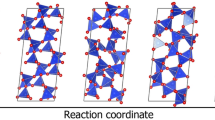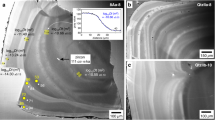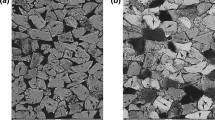Abstract
HITHERTO the most successful methods1,2 of growing large quartz crystals have employed a hydrothermal technique in which melting-quality quartz is used as the source material for maintaining the supersaturation of the liquid with respect to silica in the vicinity of the growing crystals. We have now found means whereby the melting-quality quartz can be replaced satisfactorily by other mineral substances rich in silica, such as flint and quartzite. These materials have the advantage of ready availability in the United Kingdom.
This is a preview of subscription content, access via your institution
Access options
Subscribe to this journal
Receive 51 print issues and online access
$199.00 per year
only $3.90 per issue
Buy this article
- Purchase on SpringerLink
- Instant access to full article PDF
Prices may be subject to local taxes which are calculated during checkout
Similar content being viewed by others
References
Walker, A. C., et al., Indust. and Eng. Chem., 42, 1369 (1950); 46, 1670 (1954).
Brown, C. S., et al., Min. Mag., 29, 858 (1952); Acta Cryst., 7, 668 (1954).
British Patent Applications Nos. 13753/53, May 15, 1953; 27169/53, Oct. 2, 1953.
Griffiths, J. H. E., et al., Nature, 173, 439 (1954).
Author information
Authors and Affiliations
Rights and permissions
About this article
Cite this article
BROWN, C., KELL, R., MIDDLETON, P. et al. Influence of Impurities on the Growth of Quartz Crystals from Flint and Quartzite. Nature 175, 602–603 (1955). https://doi.org/10.1038/175602a0
Issue date:
DOI: https://doi.org/10.1038/175602a0
This article is cited by
-
Thermodynamic Modeling of Saponin Adsorption Behavior on Sandstone Rocks: An Experimental Study
Arabian Journal for Science and Engineering (2022)
-
Intriguing minerals: quartz and its polymorphic modifications
ChemTexts (2022)



